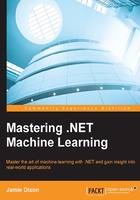
Why .NET?
If you are a Windows developer, using .NET is something you do without thinking. Indeed, a vast majority of Windows business applications written in the last 15 years use managed code—most of it written in C#. Although it is difficult to categorize millions of software developers, it is fair to say that .NET developers often come from nontraditional backgrounds. Perhaps a developer came to .NET from a BCSC degree but it is equally likely s/he started writing VBA scripts in Excel, moving up to Access applications, and then into VB.NET/C# applications. Therefore, most .NET developers are likely to be familiar with C#/VB.NET and write in an imperative and perhaps OO style.
The problem with this rather narrow exposure is that most machine learning classes, books, and code examples are in R or Python and very much use a functional style of writing code. Therefore, the .NET developer is at a disadvantage when acquiring machine learning skills because of the need to learn a new development environment, a new language, and a new style of coding before learning how to write the first line of machine learning code.
If, however, that same developer could use their familiar IDE (Visual Studio) and the same base libraries (the .NET Framework), they can concentrate on learning machine learning much sooner. Also, when creating machine learning models in .NET, they have immediate impact as you can slide the code right into an existing C#/VB.NET solution.
On the other hand, .NET is under-represented in the data science community. There are a couple of different reasons floating around for that fact. The first is that historically Microsoft was a proprietary closed system and the academic community embraced open source systems such as Linux and Java. The second reason is that much academic research uses domain-specific languages such as R, whereas Microsoft concentrated .NET on general purpose programming languages. Research that moved to industry took their language with them. However, as the researcher's role is shifted from data science to building programs that can work at real time that customers touch, the researcher is getting more and more exposure to Windows and Windows development. Whether you like it or not, all companies which create software that face customers must have a Windows strategy, an iOS strategy, and an Android strategy.
One real advantage to writing and then deploying your machine learning code in .NET is that you can get everything with one stop shopping. I know several large companies who write their models in R and then have another team rewrite them in Python or C++ to deploy them. Also, they might write their model in Python and then rewrite it in C# to deploy on Windows devices. Clearly, if you could write and deploy in one language stack, there is a tremendous opportunity for efficiency and speed to market.